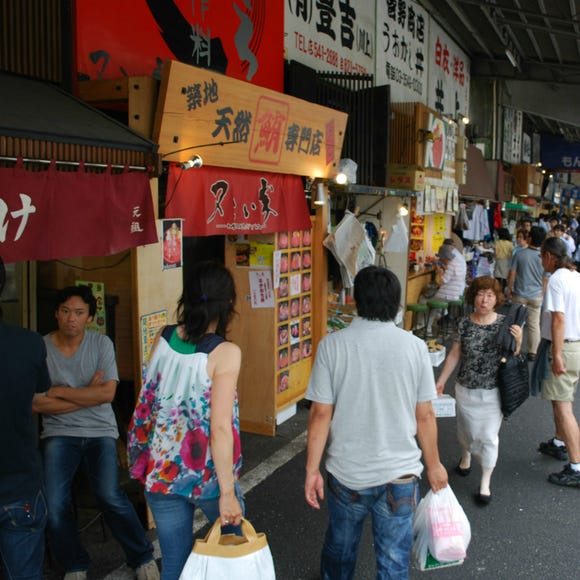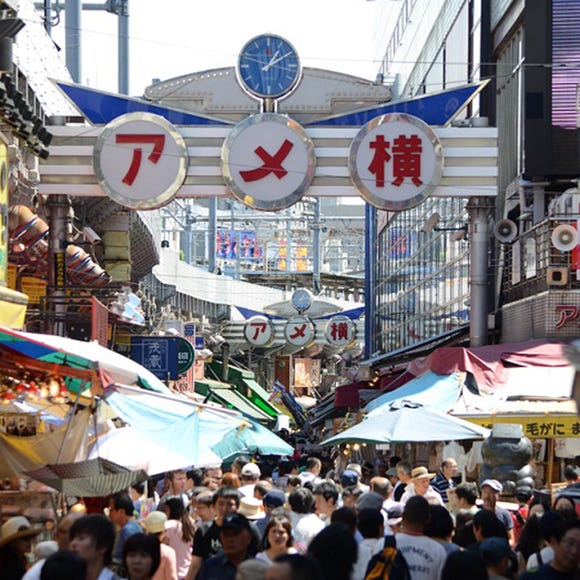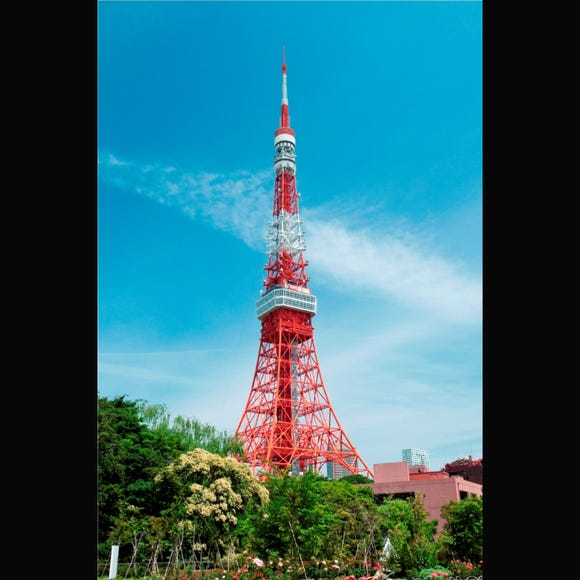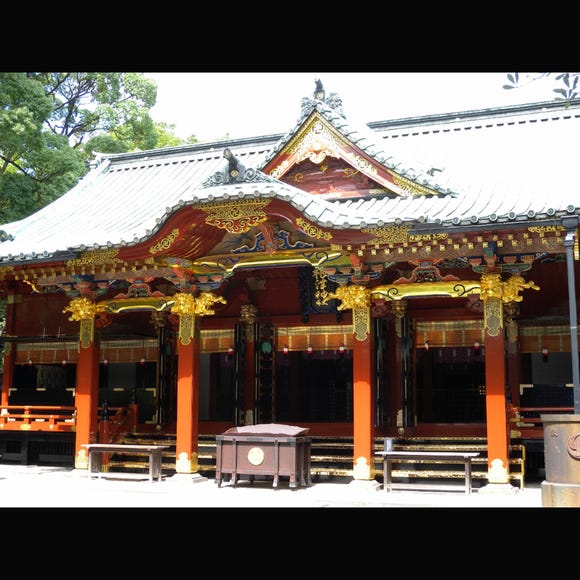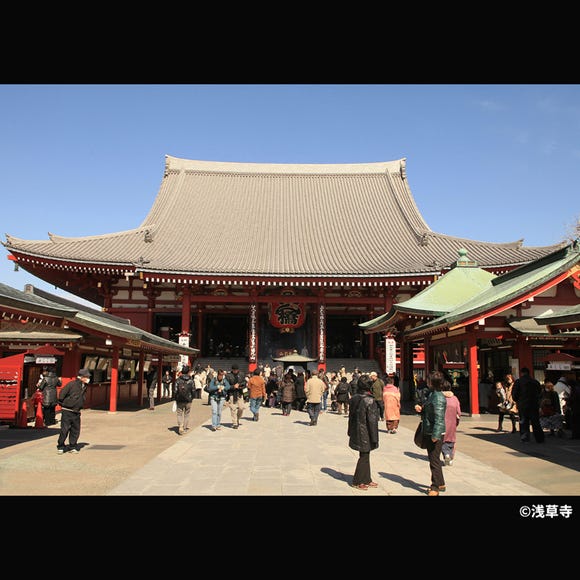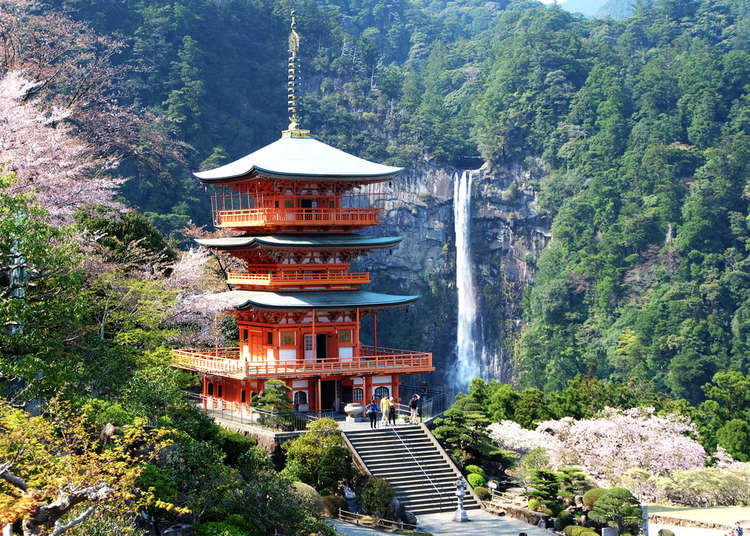
With regular travel being out of the window for the forseeable future, travel round Japan virtually with these gorgeous landscapes instead.
With a variety of magnificent locations, from national parks to flourescent ponds all the way to sandy beaches and historic towns, Japan is the perfect place to explore from your computer screen.
Whether you’re setting up your itinery for your next trip to Japan or you just want to daydream, here are 20 traditional Japanese landscapes that will take your breath away.
1. Hoshitouge Tanada Rice Field

Non-Japanese people might have never heard of rice paddies before. They’re tiered fields used by farmers to grow rice, and not only are they strikingly gorgeous, but they’re a way of life for some Japanese natives.
Rice paddies can be found all across Japan, but the rice field in the small village of Hoshitouge, Tanada is one of the most popular due to its awe-inspiring beauty. The tiers of farmland appear to stretch on endlessly, and the pools of water have a dazzling, crystal-like surface.
The rice field itself is off-limits to the public since its private farmland, but there are a number of elevated viewing spots that you can gaze from.
2. Alpine Route
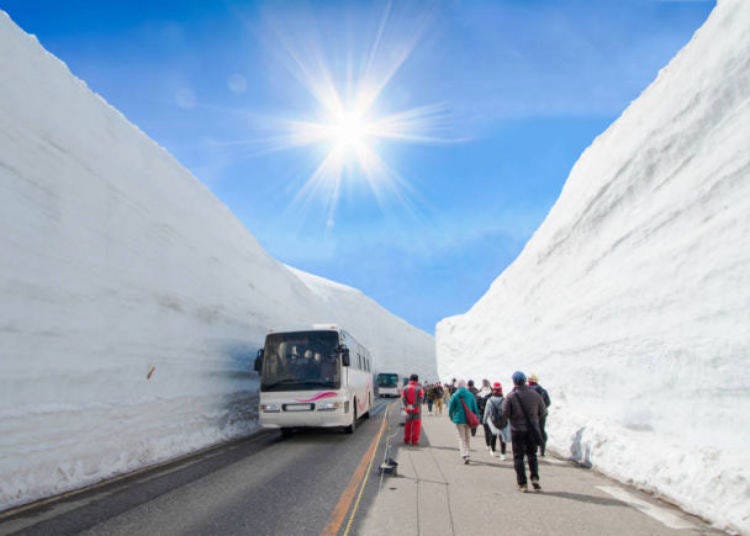
The Tateyama Kurobe Alpine Route is one of the most unique landscapes on earth, let alone in Japan. This magnificent route through the Northern Japan Alps boasts breathtaking views of the Tateyama Mountain Range, and in winter and spring, the walls of the mountains form ‘snow corridors’ from the accumulated snow, some of which reach up to 65ft high.
In summer and autumn, you’ll find a completely different mountain landscape, flush with autumn leaves and large areas of greenery. No matter what time of the year you visit the Tateyama Kurobe Alpine Route, you’re sure to see some stunning visuals.
3. Strolling Garden (Kenrokuen, Kanazawa)
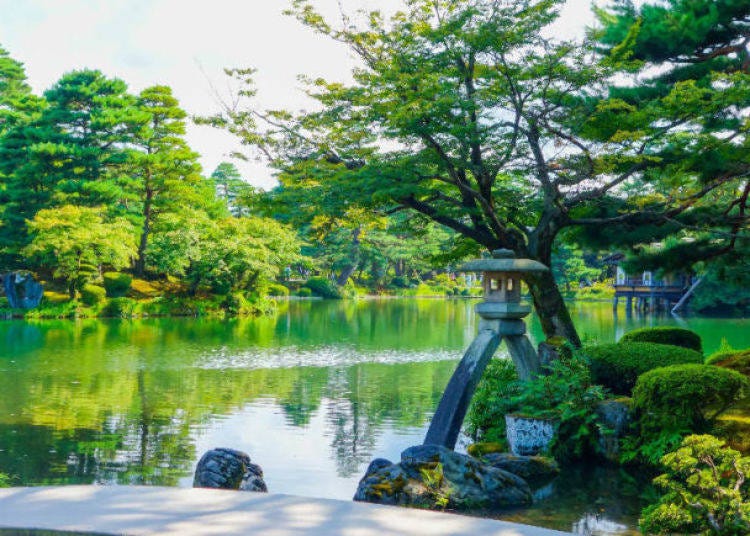
There are a number of different garden types throughout Japan, but the one thing they have in common is that they’re always majestically gorgeous.
A strolling garden is connected by several different pathways, usually with a pond or lake at the center, allowing people to leisurely stroll around them and take in the garden’s natural beauty. They include shrubs, grass, cherry or plum trees, artificial hills and sometimes stone decorations.
Strolling garden paths are designed to evoke a sense of adventure and have been an important part of Japanese culture for centuries. This particular garden can be found in Japan’s Kanazawa.
4. Shirogane Blue Pond
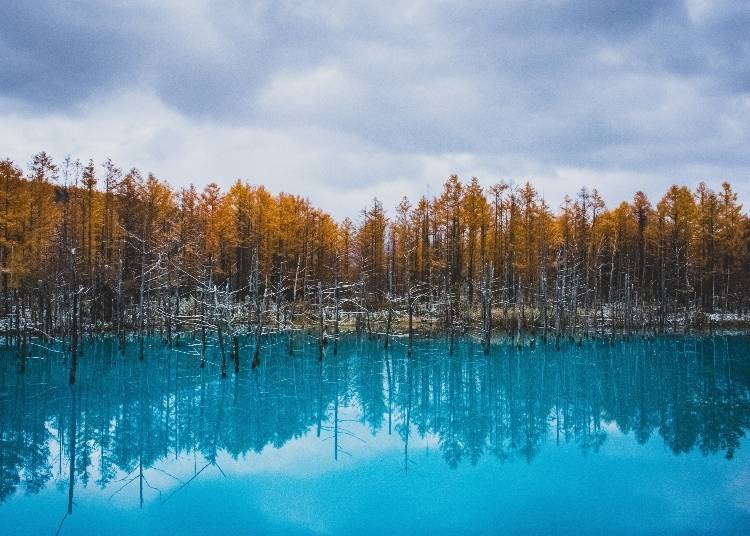
No, your eyes don’t deceive you. The waters in the Shirogane Blue Pond really are that shade of blue. The pond is so visually incredible that it looks like something from another world.
It’s located in Biei in Hokkaido and depending on the season, the Shirogane Blue Pond ranges in color from a fluorescent blue to a light emerald green.
The reason for its incredible color is actually a happy accident caused by aluminum impurities. The pond was created as a way to stop mudflow from the nearby Mount Tokachi, and the pond is fed by waters from the Shirahige waterfall. Aluminum from the mountain rocks mix with the waterfall and then flow into the Shirogane Blue Pond.
In addition to the magnificent color, another unique aspect of the Shirogane Blue Pond is the cluster of old (no longer living) trees that sit in the middle of it. It’s an eerie sight, but gorgeous nonetheless!
5. Mount Fuji from the Chureito Pagoda
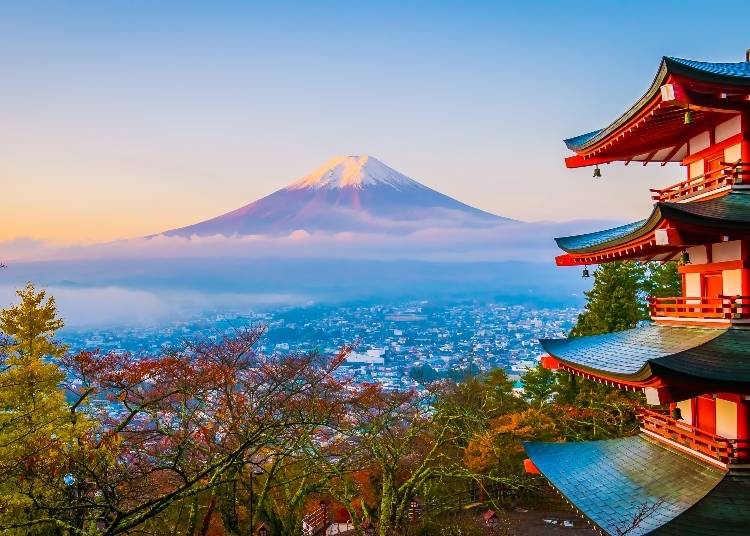
Perhaps Japan’s most iconic image, the landscape of Mount Fuji is a spectacular visual from any angle.
But if you pay a trip to the Chureito Pagoda located in Arakurayama Sengen Park in Fujiyoshida, you’ll be rewarded with the most astounding view of Mount Fuji possible. The Chureito Pagoda is part of the Arakura Sengen Shrine, and to get there you’ll need to brave 400-plus steps up the mountainside. However, the end result is certainly worth it.
6. Shirakawago
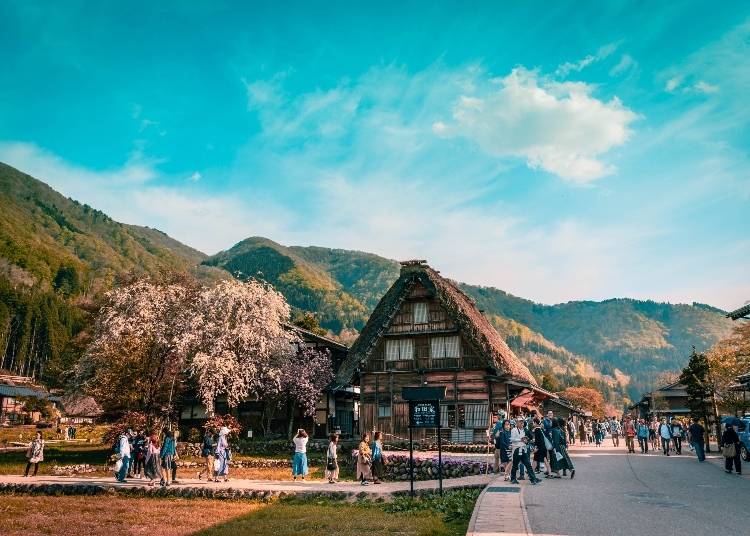
Inside the Shirakawago region is a small village called Ogimachi, and this village is very unique indeed. It’s made up of traditional thatched houses (known as Gassho houses) surrounded by vast mountainside and remains one of the few examples of this traditional approach still standing in Japan.
Due to the natural surroundings, natives were forced to adapt their living ways to survive heavy snow and rainfall. The houses are tall and narrow with thatched roofs and were built entirely without nails in the 1800s. Most of them still stand today.
Some of the homes in Ogimachi have been turned into guesthouses, so you too can experience what rural Japanese living was like in the nineteenth century. Nearby is the Shirayama Observatory, which allows spellbinding views of the historical site.
7. Tsumago
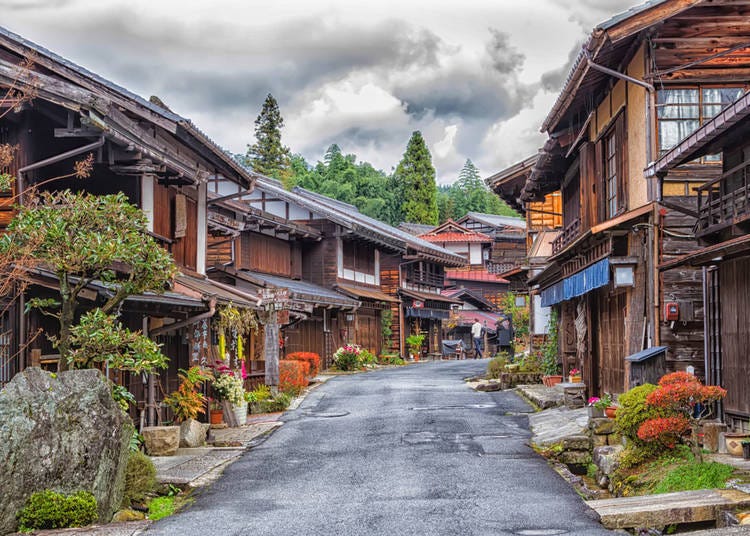
Tsumago has been referred to as an ‘open-air museum village’. Located in the town of Nagiso in Nagano Prefecture, it’s a preserved Edo-period town which allows you to sample the delights of Japan’s yesteryear.
Tsumago is home to old-style wooden houses, inns, traditional stores and castle ruins, all of which boast brownish, earthy tones which contrast against the lush green tones of the distant hills.
Japanese officials have gone to great lengths to preserve Tsumago’s old-world atmosphere, even going as far as to ban all cars and hide all phone and power cables. It’s the closest you’ll get to stepping back in time to the Edo era.
8. Oirase Gorge
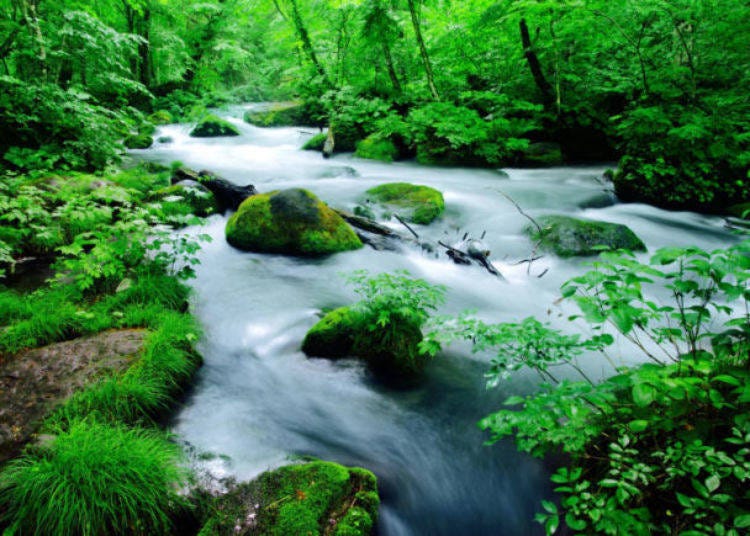
In the summer, Oirase Gorge is one of the most picturesque locations in Japan. The dense trees surrounding the river are so green and vibrant that the river surface is often tinted green with their reflection. Conversely in autumn, the vibrant reds and oranges take to the stage for a fairytale-like atmosphere.
Located in Aomori Prefecture, Oirase Gorge is fed by a dozen waterfalls and stretches on for 14 kilometers from Lake Towada to the base of Mount Hakkoda. It’s a popular trail for hikers and bicyclists, and has become a hotspot to indulge the modern trend of shinrinyoku (‘forest bathing’).
-
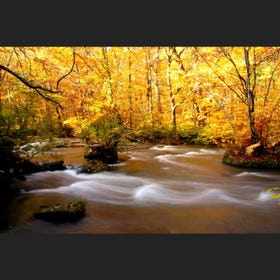
-
Address
Oirase Keiryu building, Towada-shi, Aomori larger section of a village Okuse character Tochikubo 183, 034-0301
View Map -
Nearest Station
Shichinohe-towada Station (Tohoku Shinkansen / Hokkaido Shinkansen)
- Phone Number 0176-74-1233
-
Address
Oirase Keiryu building, Towada-shi, Aomori larger section of a village Okuse character Tochikubo 183, 034-0301
9. Okunoin cemetery
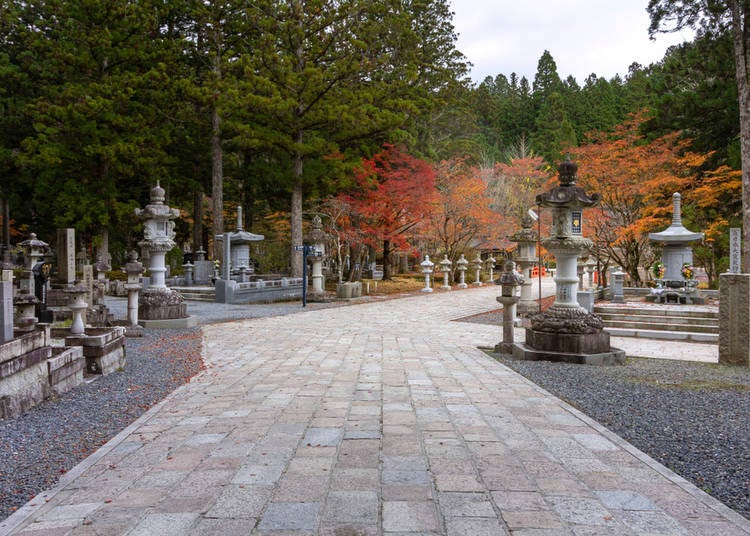
A world away from scenic mountains and lush paradises is the morbidly beautiful Okunoin cemetery in the ancient village of Koya-san in the Wakayama Prefecture.
Stretching for over 2 kilometers, Okunoin cemetery is the largest graveyard in Japan, and is the eternal home of over 20,000 monks and prestigious religious figures. Koya-san is one of the most sacred areas of Japan as it was the birthplace of Shingon Buddhism, the founder of which now resides in Okunoin graveyard.
Interestingly (or eerily), it’s believed that Okunoin is not a home for the dead, but a place for waiting spirits which will one day be reborn. Regardless, the 200,000 unique gravestones, monuments, statues and mausoleums make for spectacular viewing.
10. Mount Yoshino
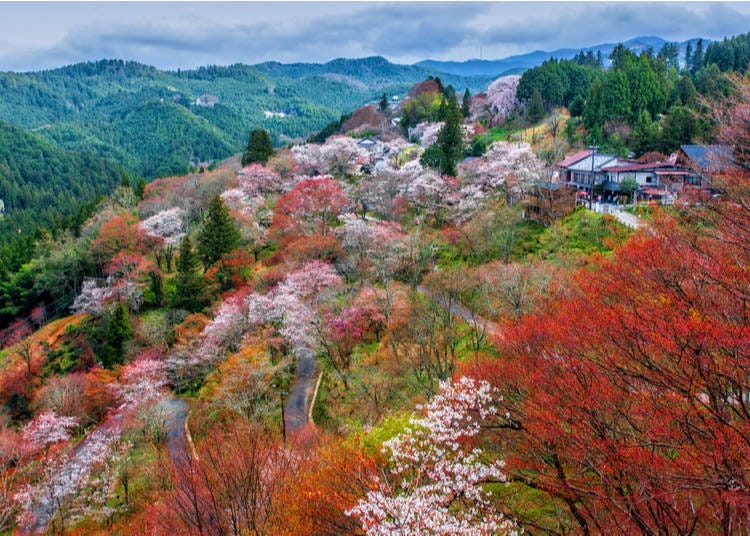
Japan is synonymous with cherry blossom trees, and the gorgeous Mount Yoshino boasts the most cherry blossoms anywhere in the world.
Mount Yoshino is a north-facing mountain in Yoshino in Nara Prefecture, with over 30,000 cherry trees adorning its slopes. Due to the sheer variety of cherry trees, the mountain is densely packed with varying shades of color, from muted pinks to bright whites. You won’t find a more astounding mountain landscape than Mount Yoshino.
11. Noto Peninsula

The Noto Peninsula is around 100 kilometers long and sticks out into the Sea of Japan in the northern half of Ishikawa Prefecture.
There’s a lot of beauty to behold in the Noto Peninsula, from small villages to zig-zagging coastlines to huge rice fields. It’s the perfect location if you want a place where you can marvel at both suburban and rural sceneries
12. Yakushima
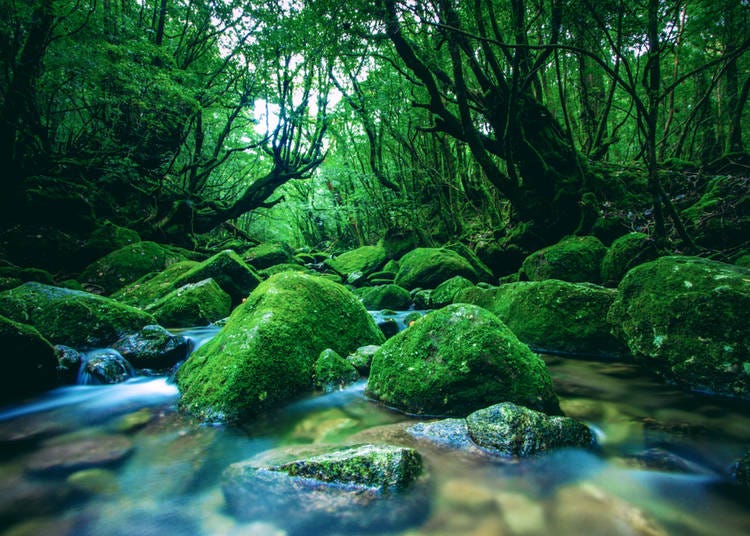
Yakushima Island is located off the coast of Kyushu in Kagoshima Prefecture. With rolling mountains and centuries-old trees, Yakushima is a dream for any explorer, whether that be virtual or in person!
The subtropical island a lush green paradise decked with caves, waterfalls, hot springs and rickety bridges. The waters are home to tropical fish all year round, and in the summer months, turtles and macaque monkeys will come out to say hello.
13. Arashiyama Bamboo Grove
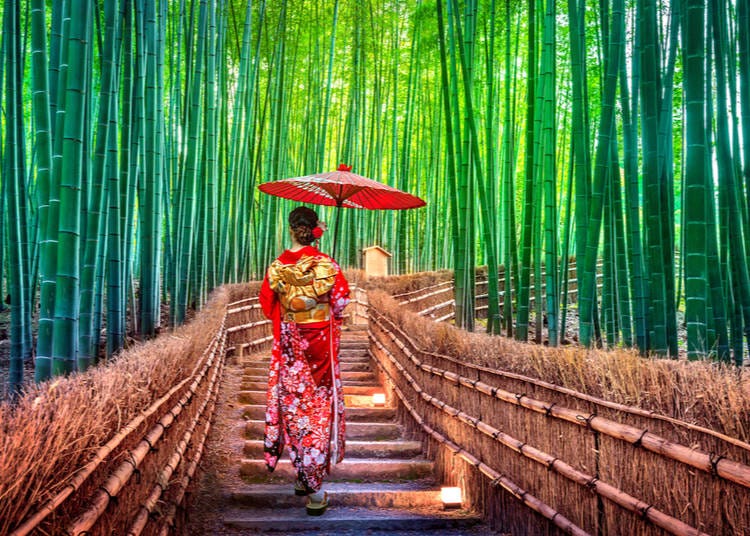
Another one of Japan’s most recognizable landscapes, the Arashiyama Bamboo Grove is like stepping into another world.
Located in Arashiyama, Kyoto, the paths of the bamboo grove are bathed in green from the endless rows of gigantic bamboo stalks either side, some of which reach up to 20 meters high. Not only is the bamboo grove one of the most popular areas in Kyoto, it’s also one of the most photographed places in the world.
-
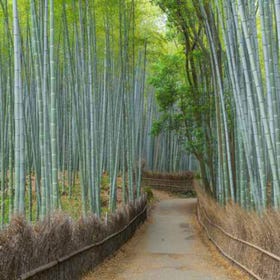
-
Address
Saga Ogurayama Tabuchiyama Town, Ukyo Ward, Kyoto City, Kyoto Prefecture, 616-8394
View Map -
Nearest Station
Torokkoarashiyama Station (Sagano Sight-seeing Tram)
1 minute on foot
- Phone Number 075-213-1717
-
Address
Saga Ogurayama Tabuchiyama Town, Ukyo Ward, Kyoto City, Kyoto Prefecture, 616-8394
14. Nachi Falls
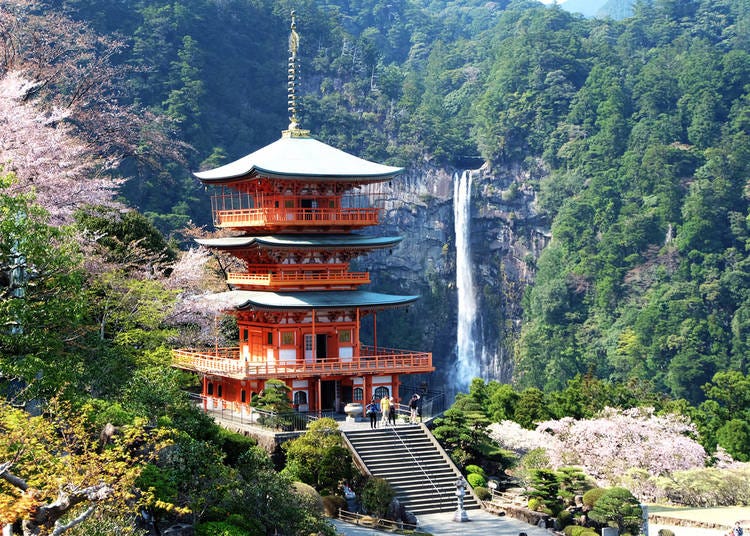
A grandiose waterfall, a shrine and a temple all in one iconic landscape? Welcome to Nachi Falls in the coastal town of Nachi, Wakayama Prefecture.
At 133 meters high, the Nachi waterfall is the largest vertical drop of any waterfall in Japan, dropping over a ton of water every second. Beside this is the gorgeous Nachi Taisha Grand Shrine and the Seigantoji Temple. The end result is a stunning contrast of gorgeous colors and a true picture of nature meeting traditional Japan.
15. Kabira Bay
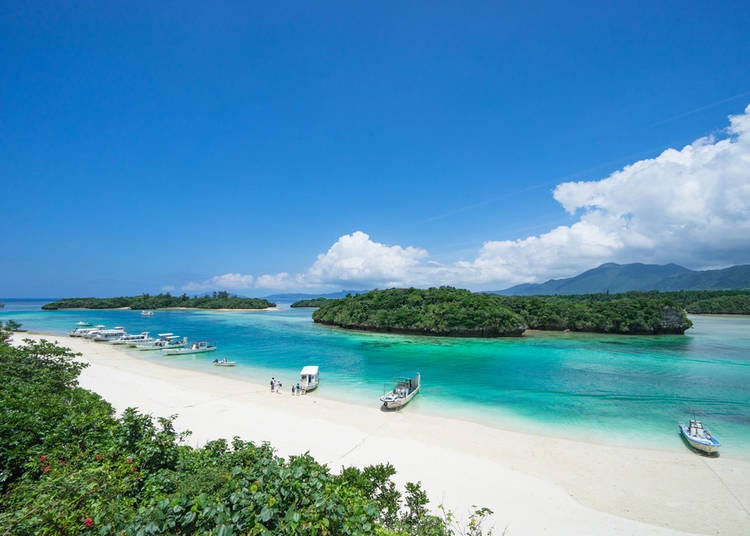
Crystal blue waters and sandy white beaches, Kabira Bay is the secret gem of Okinawa.
Located on Ishigaki Island, Kabira Bay is a tropical paradise a million miles away from Japan’s stereotypical landscapes of packed streets, ancient temples and rolling mountains. In addition to the amazing beaches, there are countless picturesque spots in Kabira Bay, including a lighthouse and the biggest blue coral habitat anywhere in the world.
16. Kanmangafuchi Abyss
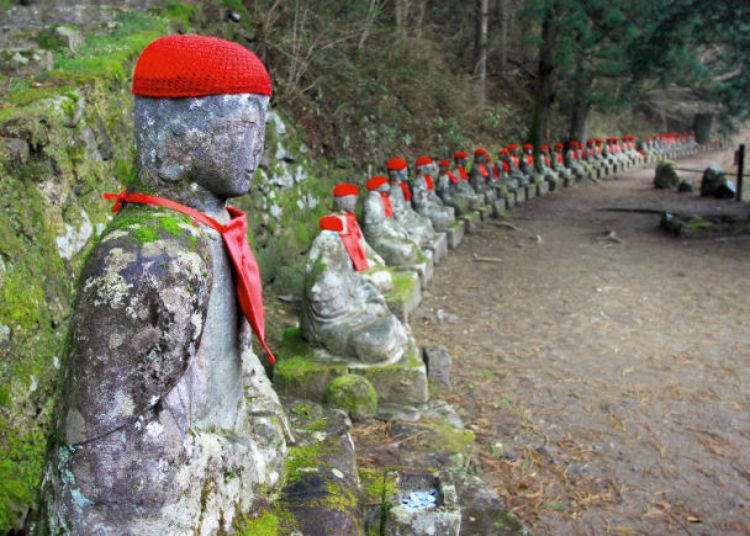
In the mountain city of Nikko lies the formidable but beautiful Kanmangafuchi Abyss.
The gorge was formed as a result of a volcanic eruption by the nearby Mount Nantai some 7000 years ago, and is one of the most immersive locations in the whole of Japan, but lacks the sprawling crowds of tourists many similar places face.
In addition to the jagged rocks, flowing waters and vibrant greenery, the Kanmangafuchi Abyss also has another unique feature. The bakejizo (‘ghost jizo’) are a row of small Buddhist statues who overlook the abyss. Local legend says that these statues vanish like ghosts, and that you’ll count a different number of them depending on which direction you’re walking.
17. Takachiho Gorge
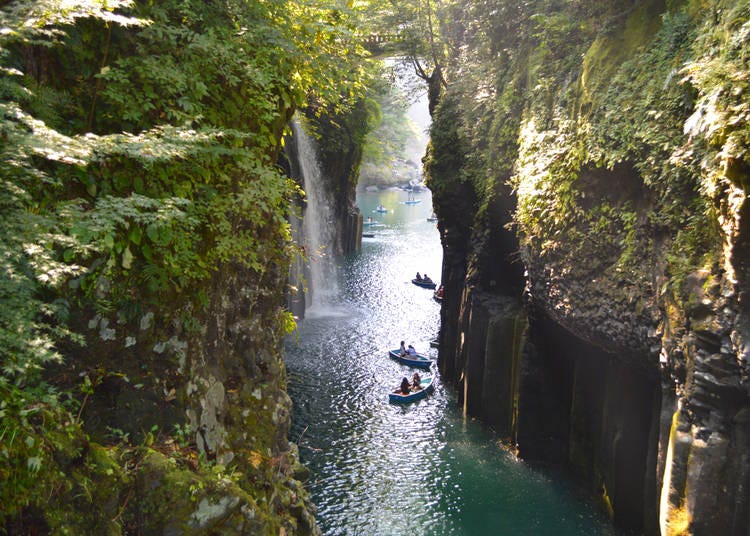
While we’re on the subject, here’s another incredible Japanese landscape formed because of a volcanic eruption.
The Takachiho Gorge in the small town of Takachiho in Kyushu is a majestic and sometimes imposing vision. Inside the Gorge is the cascading Manai Falls, a 60ft tower of gushing water, and the mountain walls are rife with plants, trees and shrubbery.
More adventurous visitors to the gorge can sample the waters up close by boat, but for those who just want to take in the extravagant views can do so on the bridge and promenade overhead.
18. Shimabara
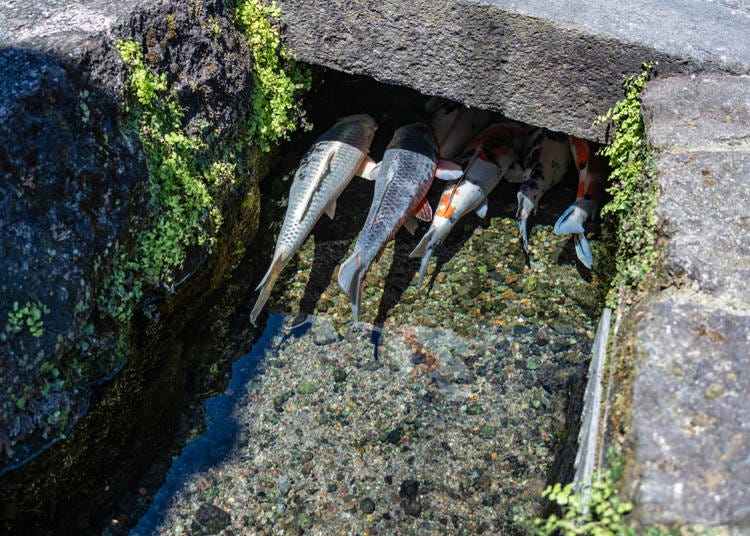
We’ve all seen the waterways of Venice, but have you ever seen a street swimming with carp?
Enter the city of Shimabara on Kyushu Island, the little-known City of Water. There are around 60 known springs throughout Shimabara, all of which pump out some of the cleanest water in the country. The city has so much water flowing through it that it spills out into drain channels along the streets, filling them up like mini-canals.
In 1978, Japanese officials decided to put koi in these drain channels since the water was so pure. Over time, the koi have overtaken the city, and can now be found in the waters all over Shamabara.
19. Aso-Kuju National Park
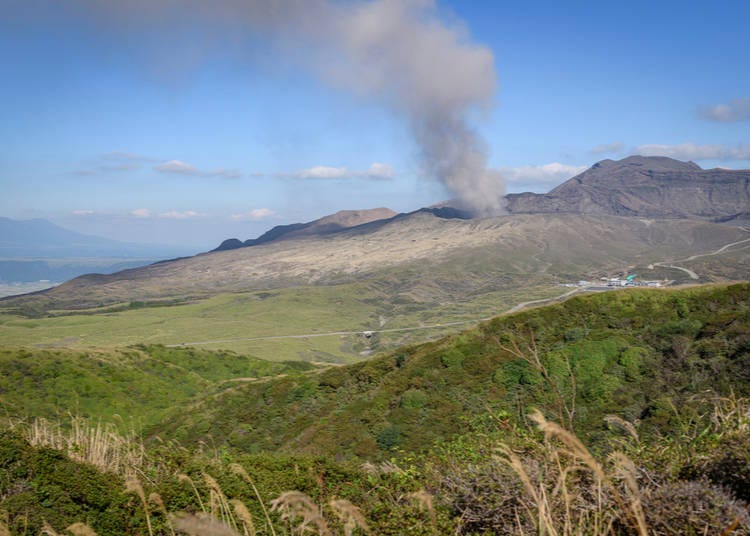
Stretching from Oita to Kunamoto in Central Kyushu, Aso-Kuju National Park is a stunning landscape of epic proportions.
Listing all of the incredible sights inside the park could take up an article itself, but the most visually delightful part of Aso-Kuju is the towering outline of the Kuju mountains and Mount Aso, the largest active volcano in Japan.
20. Tottori Sand Dunes
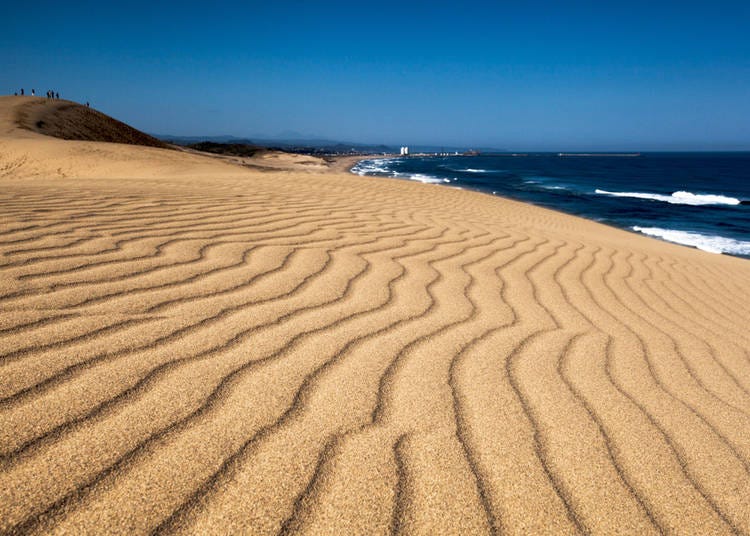
You might not associate desert landscapes with Japan, but the Tottori Sand Dunes might change that.
Spanning over 16kms, these are the only large sand hills anywhere in Japan. The dunes are made up of sand and volcanic ash, and amazingly, they continually change shape depending on the wind direction.
So there you have it, 20 stunning landscapes of Japan. But, if you’re still in the mood for some stunning Japanese visuals, don’t worry, we’ve got plenty!
Written by:

- Area
- Category
*Prices and options mentioned are subject to change.
*Unless stated otherwise, all prices include tax.
Limited time offer: 10% discount coupons available now!
-

Step Into the Story: Inside Immersive Fort Tokyo
-

15 Must-Try Restaurants in Ikebukuro: From Aged Yakiniku to All-You-Can-Eat Sushi, Plus Adorable Animal Cafés
-

Where to Eat in Yokohama: 10 Must-Try Restaurants for Yakiniku, Izakayas, Unique Dining & More
-

Professional Photos Even Beginners Can Shoot! 10 Tips for Taking Stunning Cherry Blossom Photos
-

Where to Eat in Shibuya: 14 Must-Try Restaurants for Yakiniku, Sushi, Izakayas, Cafes and More
-

Discover Osaka Station City: A Journey Through Its Most Fascinating Spots
-
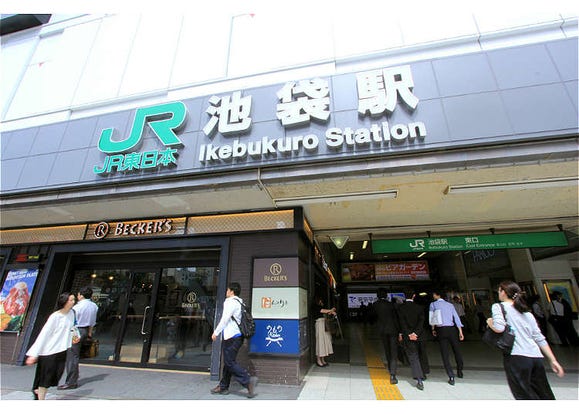
Essential Tokyo: The Complete Guide to Ikebukuro Station
-
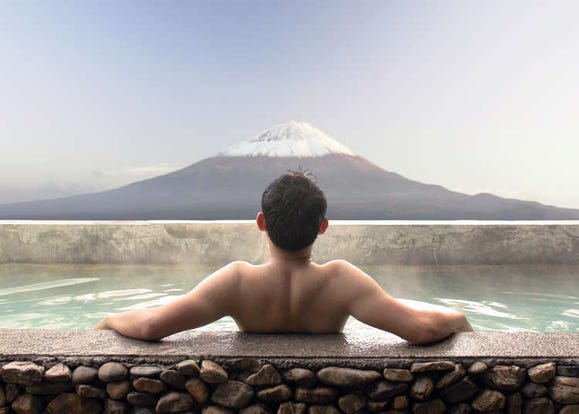
Japan's Bath Culture: Tips You Should Know!
-

Tokyo Train Map: The Complete Guide to Tokyo Subways & Railways
-

Secrets to Shopping in Japan: Guide to Annual Sales in Japan & Where to Shop
-
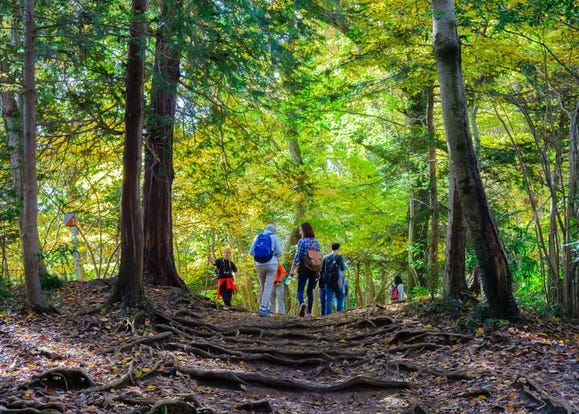
Day Hiking Near Tokyo: 6 Easy Hikes You Can Do While Visiting Japan
-
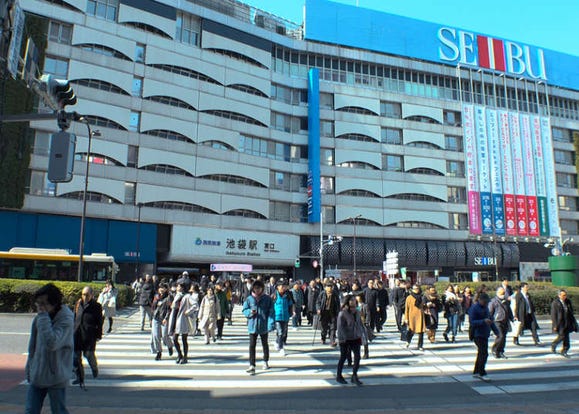
Ikebukuro Station Area Guide: Top 15 Spots When You Escape the Station's Maze!
- #best ramen tokyo
- #what to buy in ameyoko
- #what to bring to japan
- #new years in tokyo
- #best izakaya shinjuku
- #things to do tokyo
- #japanese nail trends
- #what to do in odaiba
- #onsen tattoo friendly tokyo
- #daiso
- #best sushi ginza
- #japanese convenience store snacks
- #best yakiniku shibuya
- #japanese fashion culture
- #best japanese soft drinks
















